Financial Information Report: Analysis of GM Punjabi Ltd Finances
VerifiedAdded on 2022/05/05
|18
|6157
|31
Report
AI Summary
This report, prepared for a Qualifi Level 4 Diploma in Business Management, provides a comprehensive analysis of financial information, accounting frameworks, and regulations, specifically focusing on the case of GM Punjabi Ltd. The report begins by defining financial information and its importance, purpose, limitations, and the stakeholders involved. It then identifies and explains various accounting arrangements and conventions used by organizations. The core of the report examines the influence of accounting frameworks and regulations on financial arrangements, the uses of published financial information, and the application of management accounting practices. Furthermore, the report delves into the main items commented on in financial statements and identifies trends in published accounting information. The report concludes with recommendations and a summary of the key findings, providing valuable insights into financial management and reporting practices. This report is available on Desklib, a platform offering AI-powered study tools for students.
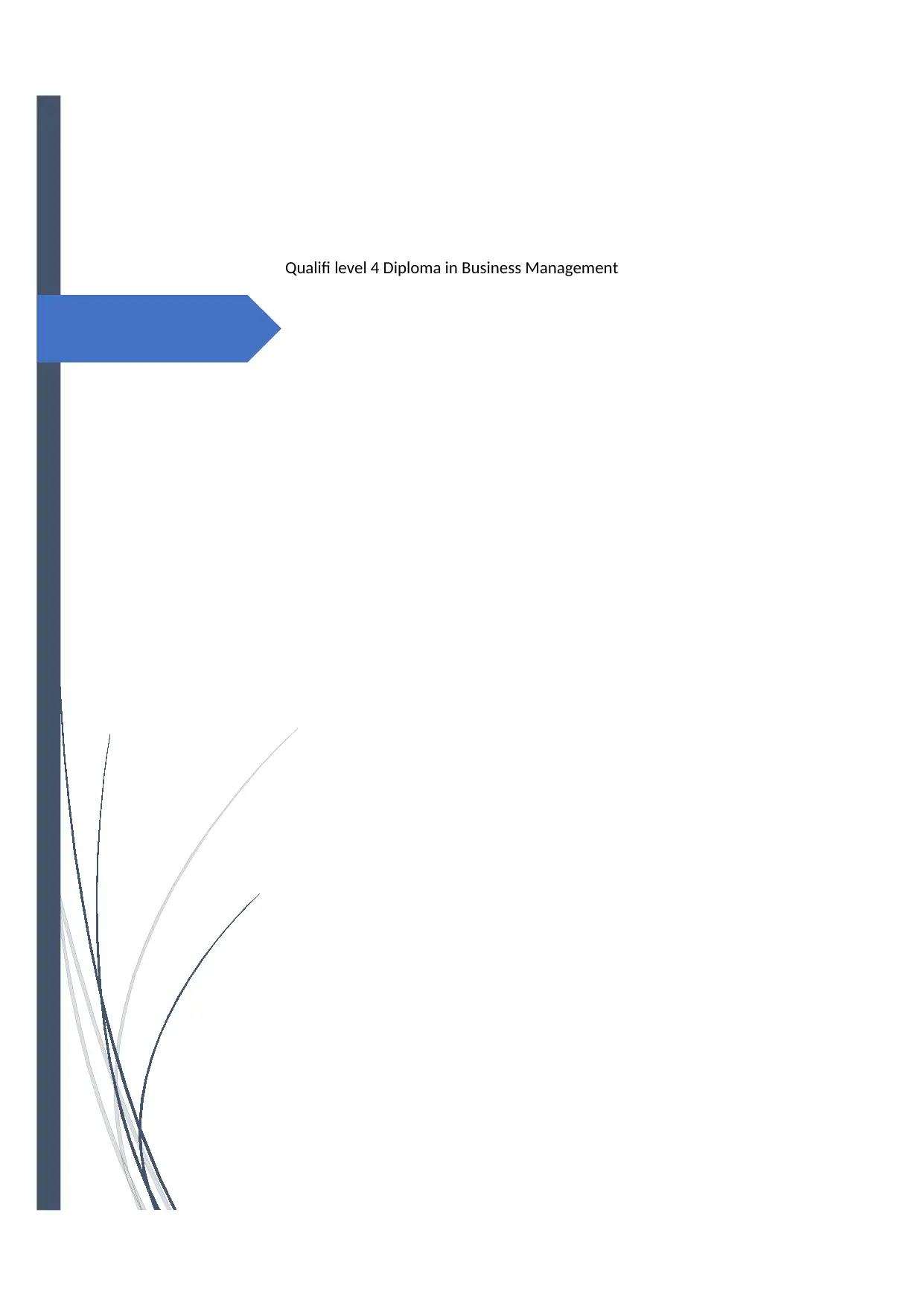
Qualifi level 4 Diploma in Business Management
Paraphrase This Document
Need a fresh take? Get an instant paraphrase of this document with our AI Paraphraser
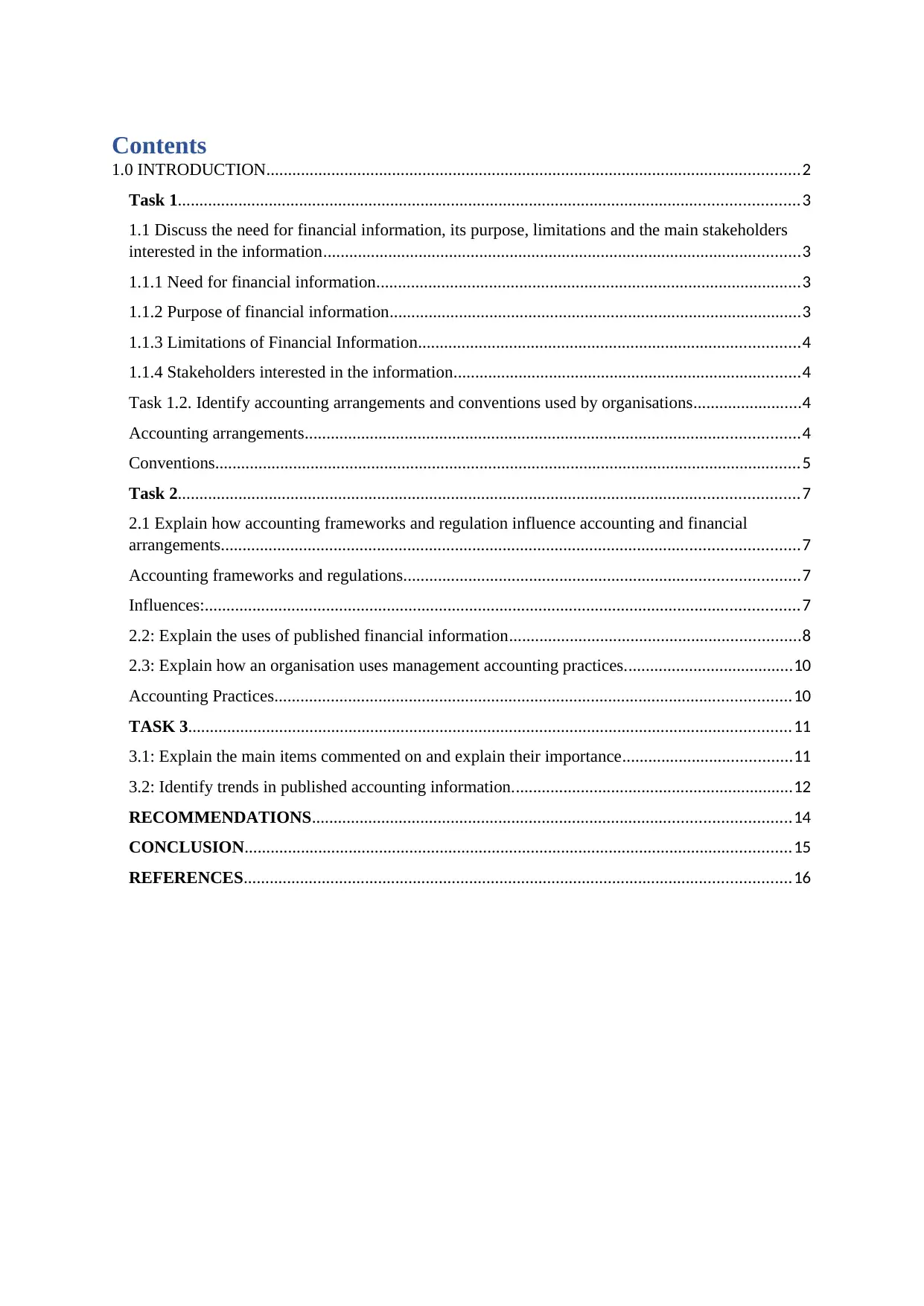
Contents
1.0 INTRODUCTION...........................................................................................................................2
Task 1...............................................................................................................................................3
1.1 Discuss the need for financial information, its purpose, limitations and the main stakeholders
interested in the information..............................................................................................................3
1.1.1 Need for financial information..................................................................................................3
1.1.2 Purpose of financial information...............................................................................................3
1.1.3 Limitations of Financial Information........................................................................................4
1.1.4 Stakeholders interested in the information................................................................................4
Task 1.2. Identify accounting arrangements and conventions used by organisations.........................4
Accounting arrangements..................................................................................................................4
Conventions.......................................................................................................................................5
Task 2...............................................................................................................................................7
2.1 Explain how accounting frameworks and regulation influence accounting and financial
arrangements.....................................................................................................................................7
Accounting frameworks and regulations...........................................................................................7
Influences:.........................................................................................................................................7
2.2: Explain the uses of published financial information...................................................................8
2.3: Explain how an organisation uses management accounting practices.......................................10
Accounting Practices.......................................................................................................................10
TASK 3...........................................................................................................................................11
3.1: Explain the main items commented on and explain their importance.......................................11
3.2: Identify trends in published accounting information.................................................................12
RECOMMENDATIONS..............................................................................................................14
CONCLUSION..............................................................................................................................15
REFERENCES..............................................................................................................................16
1.0 INTRODUCTION...........................................................................................................................2
Task 1...............................................................................................................................................3
1.1 Discuss the need for financial information, its purpose, limitations and the main stakeholders
interested in the information..............................................................................................................3
1.1.1 Need for financial information..................................................................................................3
1.1.2 Purpose of financial information...............................................................................................3
1.1.3 Limitations of Financial Information........................................................................................4
1.1.4 Stakeholders interested in the information................................................................................4
Task 1.2. Identify accounting arrangements and conventions used by organisations.........................4
Accounting arrangements..................................................................................................................4
Conventions.......................................................................................................................................5
Task 2...............................................................................................................................................7
2.1 Explain how accounting frameworks and regulation influence accounting and financial
arrangements.....................................................................................................................................7
Accounting frameworks and regulations...........................................................................................7
Influences:.........................................................................................................................................7
2.2: Explain the uses of published financial information...................................................................8
2.3: Explain how an organisation uses management accounting practices.......................................10
Accounting Practices.......................................................................................................................10
TASK 3...........................................................................................................................................11
3.1: Explain the main items commented on and explain their importance.......................................11
3.2: Identify trends in published accounting information.................................................................12
RECOMMENDATIONS..............................................................................................................14
CONCLUSION..............................................................................................................................15
REFERENCES..............................................................................................................................16
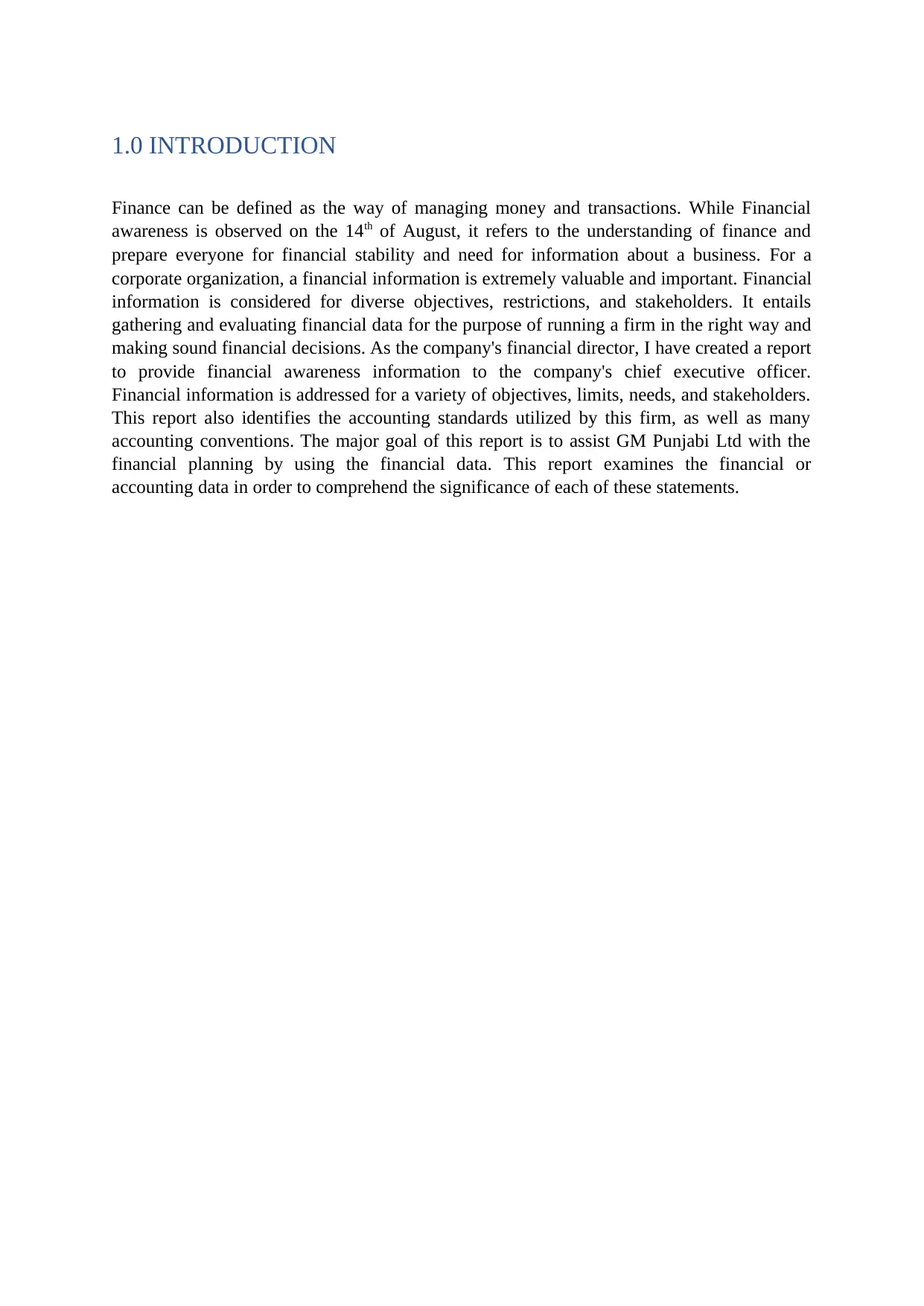
1.0 INTRODUCTION
Finance can be defined as the way of managing money and transactions. While Financial
awareness is observed on the 14th of August, it refers to the understanding of finance and
prepare everyone for financial stability and need for information about a business. For a
corporate organization, a financial information is extremely valuable and important. Financial
information is considered for diverse objectives, restrictions, and stakeholders. It entails
gathering and evaluating financial data for the purpose of running a firm in the right way and
making sound financial decisions. As the company's financial director, I have created a report
to provide financial awareness information to the company's chief executive officer.
Financial information is addressed for a variety of objectives, limits, needs, and stakeholders.
This report also identifies the accounting standards utilized by this firm, as well as many
accounting conventions. The major goal of this report is to assist GM Punjabi Ltd with the
financial planning by using the financial data. This report examines the financial or
accounting data in order to comprehend the significance of each of these statements.
Finance can be defined as the way of managing money and transactions. While Financial
awareness is observed on the 14th of August, it refers to the understanding of finance and
prepare everyone for financial stability and need for information about a business. For a
corporate organization, a financial information is extremely valuable and important. Financial
information is considered for diverse objectives, restrictions, and stakeholders. It entails
gathering and evaluating financial data for the purpose of running a firm in the right way and
making sound financial decisions. As the company's financial director, I have created a report
to provide financial awareness information to the company's chief executive officer.
Financial information is addressed for a variety of objectives, limits, needs, and stakeholders.
This report also identifies the accounting standards utilized by this firm, as well as many
accounting conventions. The major goal of this report is to assist GM Punjabi Ltd with the
financial planning by using the financial data. This report examines the financial or
accounting data in order to comprehend the significance of each of these statements.
⊘ This is a preview!⊘
Do you want full access?
Subscribe today to unlock all pages.

Trusted by 1+ million students worldwide
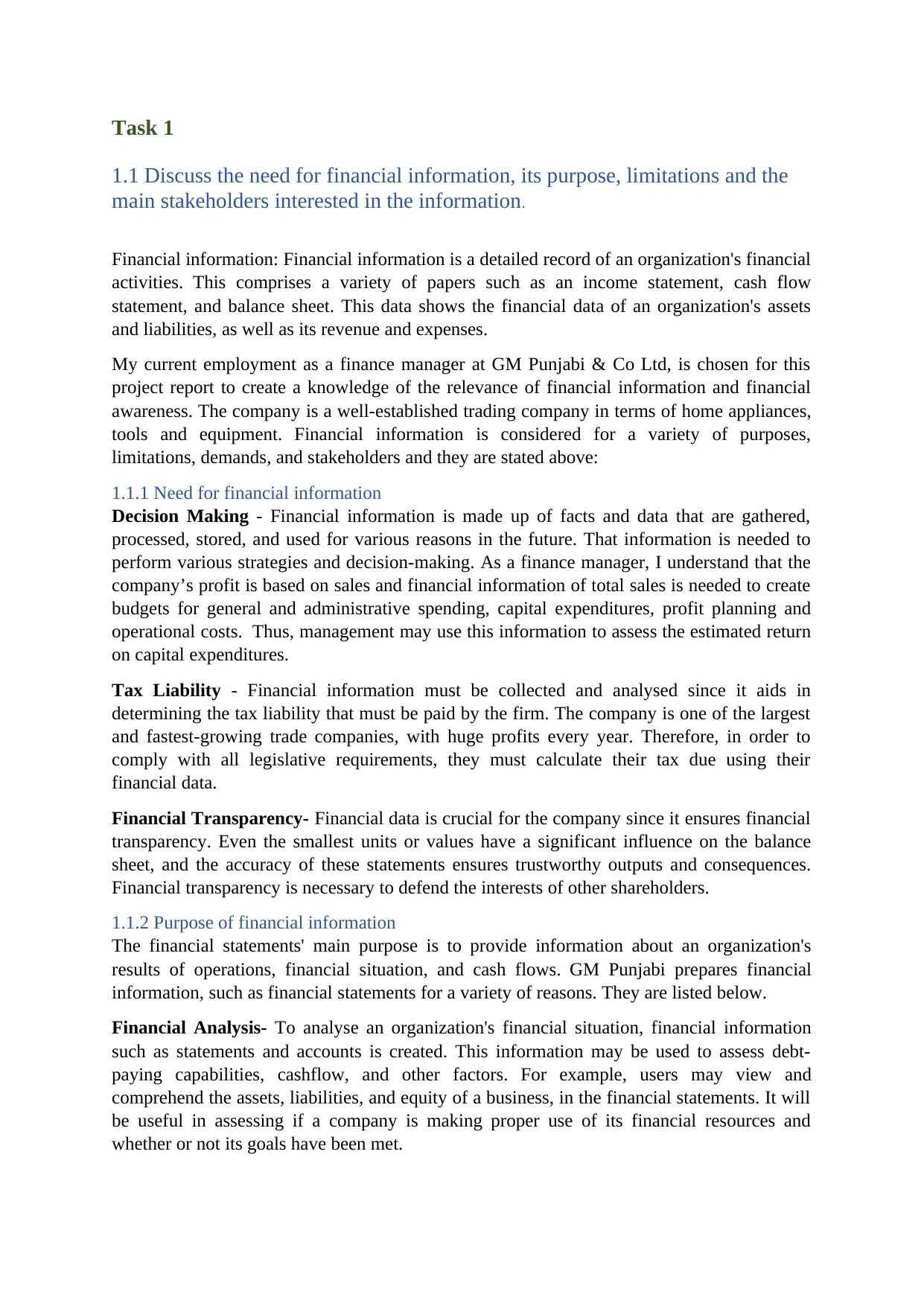
Task 1
1.1 Discuss the need for financial information, its purpose, limitations and the
main stakeholders interested in the information.
Financial information: Financial information is a detailed record of an organization's financial
activities. This comprises a variety of papers such as an income statement, cash flow
statement, and balance sheet. This data shows the financial data of an organization's assets
and liabilities, as well as its revenue and expenses.
My current employment as a finance manager at GM Punjabi & Co Ltd, is chosen for this
project report to create a knowledge of the relevance of financial information and financial
awareness. The company is a well-established trading company in terms of home appliances,
tools and equipment. Financial information is considered for a variety of purposes,
limitations, demands, and stakeholders and they are stated above:
1.1.1 Need for financial information
Decision Making - Financial information is made up of facts and data that are gathered,
processed, stored, and used for various reasons in the future. That information is needed to
perform various strategies and decision-making. As a finance manager, I understand that the
company’s profit is based on sales and financial information of total sales is needed to create
budgets for general and administrative spending, capital expenditures, profit planning and
operational costs. Thus, management may use this information to assess the estimated return
on capital expenditures.
Tax Liability - Financial information must be collected and analysed since it aids in
determining the tax liability that must be paid by the firm. The company is one of the largest
and fastest-growing trade companies, with huge profits every year. Therefore, in order to
comply with all legislative requirements, they must calculate their tax due using their
financial data.
Financial Transparency- Financial data is crucial for the company since it ensures financial
transparency. Even the smallest units or values have a significant influence on the balance
sheet, and the accuracy of these statements ensures trustworthy outputs and consequences.
Financial transparency is necessary to defend the interests of other shareholders.
1.1.2 Purpose of financial information
The financial statements' main purpose is to provide information about an organization's
results of operations, financial situation, and cash flows. GM Punjabi prepares financial
information, such as financial statements for a variety of reasons. They are listed below.
Financial Analysis- To analyse an organization's financial situation, financial information
such as statements and accounts is created. This information may be used to assess debt-
paying capabilities, cashflow, and other factors. For example, users may view and
comprehend the assets, liabilities, and equity of a business, in the financial statements. It will
be useful in assessing if a company is making proper use of its financial resources and
whether or not its goals have been met.
1.1 Discuss the need for financial information, its purpose, limitations and the
main stakeholders interested in the information.
Financial information: Financial information is a detailed record of an organization's financial
activities. This comprises a variety of papers such as an income statement, cash flow
statement, and balance sheet. This data shows the financial data of an organization's assets
and liabilities, as well as its revenue and expenses.
My current employment as a finance manager at GM Punjabi & Co Ltd, is chosen for this
project report to create a knowledge of the relevance of financial information and financial
awareness. The company is a well-established trading company in terms of home appliances,
tools and equipment. Financial information is considered for a variety of purposes,
limitations, demands, and stakeholders and they are stated above:
1.1.1 Need for financial information
Decision Making - Financial information is made up of facts and data that are gathered,
processed, stored, and used for various reasons in the future. That information is needed to
perform various strategies and decision-making. As a finance manager, I understand that the
company’s profit is based on sales and financial information of total sales is needed to create
budgets for general and administrative spending, capital expenditures, profit planning and
operational costs. Thus, management may use this information to assess the estimated return
on capital expenditures.
Tax Liability - Financial information must be collected and analysed since it aids in
determining the tax liability that must be paid by the firm. The company is one of the largest
and fastest-growing trade companies, with huge profits every year. Therefore, in order to
comply with all legislative requirements, they must calculate their tax due using their
financial data.
Financial Transparency- Financial data is crucial for the company since it ensures financial
transparency. Even the smallest units or values have a significant influence on the balance
sheet, and the accuracy of these statements ensures trustworthy outputs and consequences.
Financial transparency is necessary to defend the interests of other shareholders.
1.1.2 Purpose of financial information
The financial statements' main purpose is to provide information about an organization's
results of operations, financial situation, and cash flows. GM Punjabi prepares financial
information, such as financial statements for a variety of reasons. They are listed below.
Financial Analysis- To analyse an organization's financial situation, financial information
such as statements and accounts is created. This information may be used to assess debt-
paying capabilities, cashflow, and other factors. For example, users may view and
comprehend the assets, liabilities, and equity of a business, in the financial statements. It will
be useful in assessing if a company is making proper use of its financial resources and
whether or not its goals have been met.
Paraphrase This Document
Need a fresh take? Get an instant paraphrase of this document with our AI Paraphraser
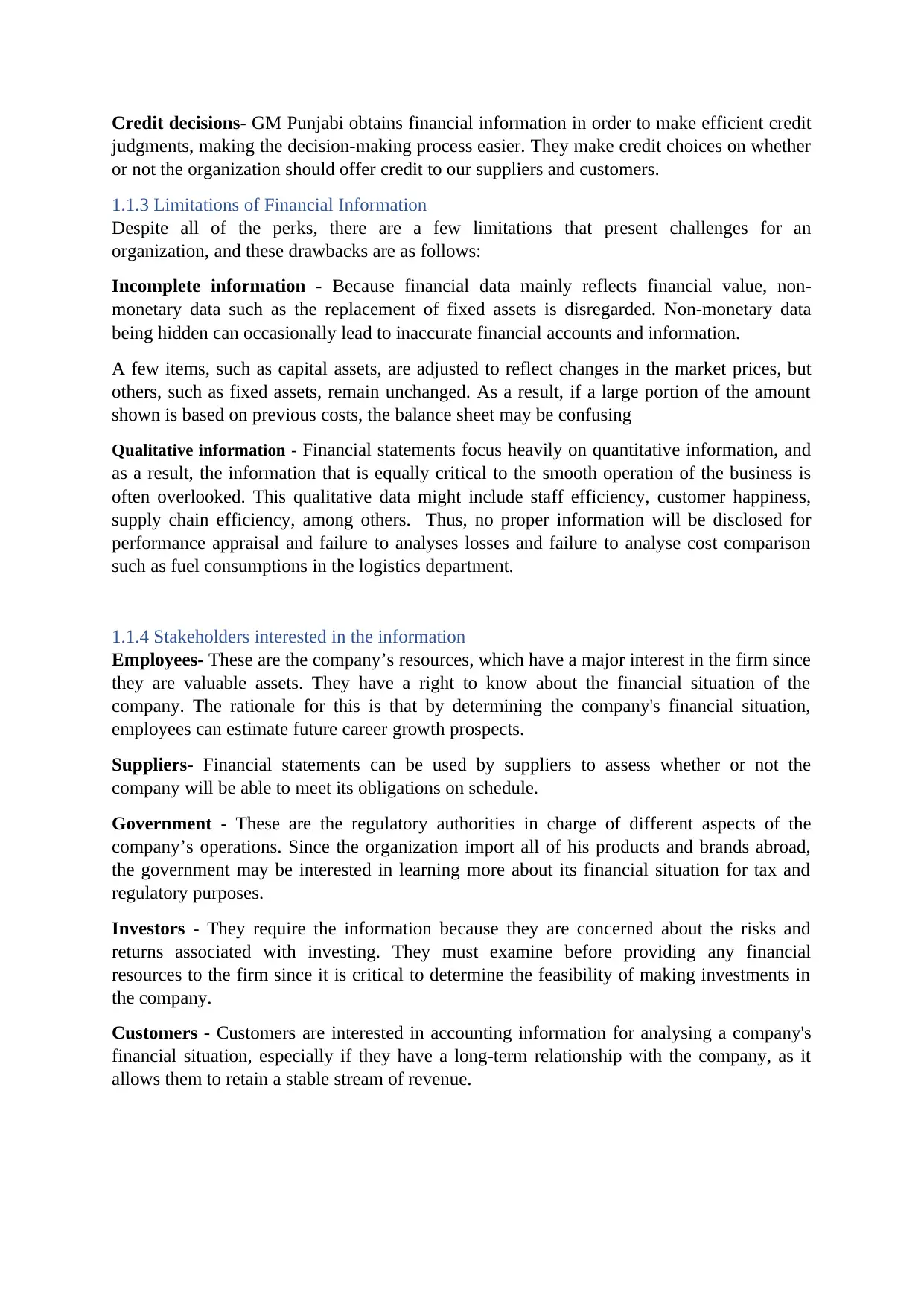
Credit decisions- GM Punjabi obtains financial information in order to make efficient credit
judgments, making the decision-making process easier. They make credit choices on whether
or not the organization should offer credit to our suppliers and customers.
1.1.3 Limitations of Financial Information
Despite all of the perks, there are a few limitations that present challenges for an
organization, and these drawbacks are as follows:
Incomplete information - Because financial data mainly reflects financial value, non-
monetary data such as the replacement of fixed assets is disregarded. Non-monetary data
being hidden can occasionally lead to inaccurate financial accounts and information.
A few items, such as capital assets, are adjusted to reflect changes in the market prices, but
others, such as fixed assets, remain unchanged. As a result, if a large portion of the amount
shown is based on previous costs, the balance sheet may be confusing
Qualitative information - Financial statements focus heavily on quantitative information, and
as a result, the information that is equally critical to the smooth operation of the business is
often overlooked. This qualitative data might include staff efficiency, customer happiness,
supply chain efficiency, among others. Thus, no proper information will be disclosed for
performance appraisal and failure to analyses losses and failure to analyse cost comparison
such as fuel consumptions in the logistics department.
1.1.4 Stakeholders interested in the information
Employees- These are the company’s resources, which have a major interest in the firm since
they are valuable assets. They have a right to know about the financial situation of the
company. The rationale for this is that by determining the company's financial situation,
employees can estimate future career growth prospects.
Suppliers- Financial statements can be used by suppliers to assess whether or not the
company will be able to meet its obligations on schedule.
Government - These are the regulatory authorities in charge of different aspects of the
company’s operations. Since the organization import all of his products and brands abroad,
the government may be interested in learning more about its financial situation for tax and
regulatory purposes.
Investors - They require the information because they are concerned about the risks and
returns associated with investing. They must examine before providing any financial
resources to the firm since it is critical to determine the feasibility of making investments in
the company.
Customers - Customers are interested in accounting information for analysing a company's
financial situation, especially if they have a long-term relationship with the company, as it
allows them to retain a stable stream of revenue.
judgments, making the decision-making process easier. They make credit choices on whether
or not the organization should offer credit to our suppliers and customers.
1.1.3 Limitations of Financial Information
Despite all of the perks, there are a few limitations that present challenges for an
organization, and these drawbacks are as follows:
Incomplete information - Because financial data mainly reflects financial value, non-
monetary data such as the replacement of fixed assets is disregarded. Non-monetary data
being hidden can occasionally lead to inaccurate financial accounts and information.
A few items, such as capital assets, are adjusted to reflect changes in the market prices, but
others, such as fixed assets, remain unchanged. As a result, if a large portion of the amount
shown is based on previous costs, the balance sheet may be confusing
Qualitative information - Financial statements focus heavily on quantitative information, and
as a result, the information that is equally critical to the smooth operation of the business is
often overlooked. This qualitative data might include staff efficiency, customer happiness,
supply chain efficiency, among others. Thus, no proper information will be disclosed for
performance appraisal and failure to analyses losses and failure to analyse cost comparison
such as fuel consumptions in the logistics department.
1.1.4 Stakeholders interested in the information
Employees- These are the company’s resources, which have a major interest in the firm since
they are valuable assets. They have a right to know about the financial situation of the
company. The rationale for this is that by determining the company's financial situation,
employees can estimate future career growth prospects.
Suppliers- Financial statements can be used by suppliers to assess whether or not the
company will be able to meet its obligations on schedule.
Government - These are the regulatory authorities in charge of different aspects of the
company’s operations. Since the organization import all of his products and brands abroad,
the government may be interested in learning more about its financial situation for tax and
regulatory purposes.
Investors - They require the information because they are concerned about the risks and
returns associated with investing. They must examine before providing any financial
resources to the firm since it is critical to determine the feasibility of making investments in
the company.
Customers - Customers are interested in accounting information for analysing a company's
financial situation, especially if they have a long-term relationship with the company, as it
allows them to retain a stable stream of revenue.
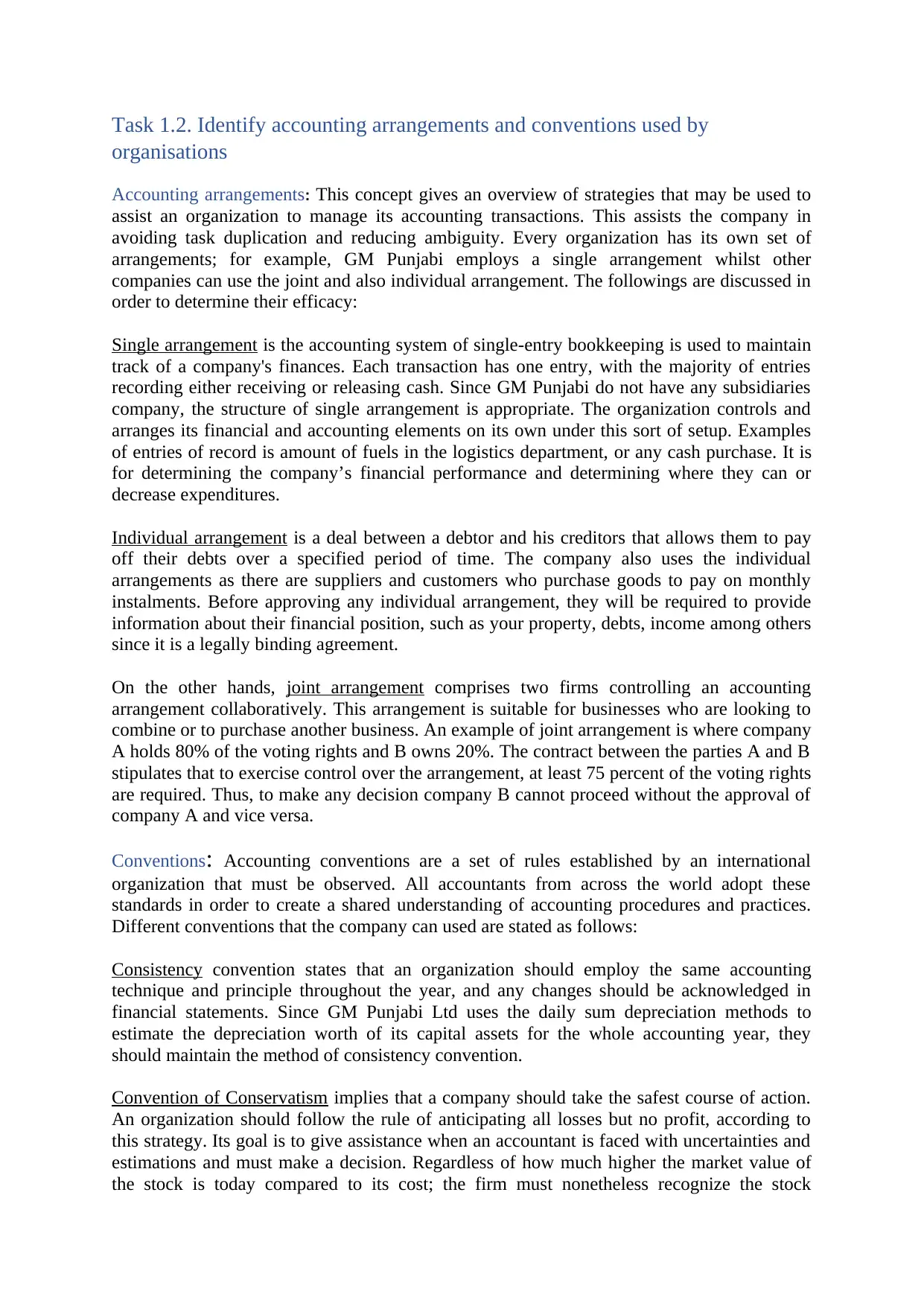
Task 1.2. Identify accounting arrangements and conventions used by
organisations
Accounting arrangements: This concept gives an overview of strategies that may be used to
assist an organization to manage its accounting transactions. This assists the company in
avoiding task duplication and reducing ambiguity. Every organization has its own set of
arrangements; for example, GM Punjabi employs a single arrangement whilst other
companies can use the joint and also individual arrangement. The followings are discussed in
order to determine their efficacy:
Single arrangement is the accounting system of single-entry bookkeeping is used to maintain
track of a company's finances. Each transaction has one entry, with the majority of entries
recording either receiving or releasing cash. Since GM Punjabi do not have any subsidiaries
company, the structure of single arrangement is appropriate. The organization controls and
arranges its financial and accounting elements on its own under this sort of setup. Examples
of entries of record is amount of fuels in the logistics department, or any cash purchase. It is
for determining the company’s financial performance and determining where they can or
decrease expenditures.
Individual arrangement is a deal between a debtor and his creditors that allows them to pay
off their debts over a specified period of time. The company also uses the individual
arrangements as there are suppliers and customers who purchase goods to pay on monthly
instalments. Before approving any individual arrangement, they will be required to provide
information about their financial position, such as your property, debts, income among others
since it is a legally binding agreement.
On the other hands, joint arrangement comprises two firms controlling an accounting
arrangement collaboratively. This arrangement is suitable for businesses who are looking to
combine or to purchase another business. An example of joint arrangement is where company
A holds 80% of the voting rights and B owns 20%. The contract between the parties A and B
stipulates that to exercise control over the arrangement, at least 75 percent of the voting rights
are required. Thus, to make any decision company B cannot proceed without the approval of
company A and vice versa.
Conventions: Accounting conventions are a set of rules established by an international
organization that must be observed. All accountants from across the world adopt these
standards in order to create a shared understanding of accounting procedures and practices.
Different conventions that the company can used are stated as follows:
Consistency convention states that an organization should employ the same accounting
technique and principle throughout the year, and any changes should be acknowledged in
financial statements. Since GM Punjabi Ltd uses the daily sum depreciation methods to
estimate the depreciation worth of its capital assets for the whole accounting year, they
should maintain the method of consistency convention.
Convention of Conservatism implies that a company should take the safest course of action.
An organization should follow the rule of anticipating all losses but no profit, according to
this strategy. Its goal is to give assistance when an accountant is faced with uncertainties and
estimations and must make a decision. Regardless of how much higher the market value of
the stock is today compared to its cost; the firm must nonetheless recognize the stock
organisations
Accounting arrangements: This concept gives an overview of strategies that may be used to
assist an organization to manage its accounting transactions. This assists the company in
avoiding task duplication and reducing ambiguity. Every organization has its own set of
arrangements; for example, GM Punjabi employs a single arrangement whilst other
companies can use the joint and also individual arrangement. The followings are discussed in
order to determine their efficacy:
Single arrangement is the accounting system of single-entry bookkeeping is used to maintain
track of a company's finances. Each transaction has one entry, with the majority of entries
recording either receiving or releasing cash. Since GM Punjabi do not have any subsidiaries
company, the structure of single arrangement is appropriate. The organization controls and
arranges its financial and accounting elements on its own under this sort of setup. Examples
of entries of record is amount of fuels in the logistics department, or any cash purchase. It is
for determining the company’s financial performance and determining where they can or
decrease expenditures.
Individual arrangement is a deal between a debtor and his creditors that allows them to pay
off their debts over a specified period of time. The company also uses the individual
arrangements as there are suppliers and customers who purchase goods to pay on monthly
instalments. Before approving any individual arrangement, they will be required to provide
information about their financial position, such as your property, debts, income among others
since it is a legally binding agreement.
On the other hands, joint arrangement comprises two firms controlling an accounting
arrangement collaboratively. This arrangement is suitable for businesses who are looking to
combine or to purchase another business. An example of joint arrangement is where company
A holds 80% of the voting rights and B owns 20%. The contract between the parties A and B
stipulates that to exercise control over the arrangement, at least 75 percent of the voting rights
are required. Thus, to make any decision company B cannot proceed without the approval of
company A and vice versa.
Conventions: Accounting conventions are a set of rules established by an international
organization that must be observed. All accountants from across the world adopt these
standards in order to create a shared understanding of accounting procedures and practices.
Different conventions that the company can used are stated as follows:
Consistency convention states that an organization should employ the same accounting
technique and principle throughout the year, and any changes should be acknowledged in
financial statements. Since GM Punjabi Ltd uses the daily sum depreciation methods to
estimate the depreciation worth of its capital assets for the whole accounting year, they
should maintain the method of consistency convention.
Convention of Conservatism implies that a company should take the safest course of action.
An organization should follow the rule of anticipating all losses but no profit, according to
this strategy. Its goal is to give assistance when an accountant is faced with uncertainties and
estimations and must make a decision. Regardless of how much higher the market value of
the stock is today compared to its cost; the firm must nonetheless recognize the stock
⊘ This is a preview!⊘
Do you want full access?
Subscribe today to unlock all pages.

Trusted by 1+ million students worldwide
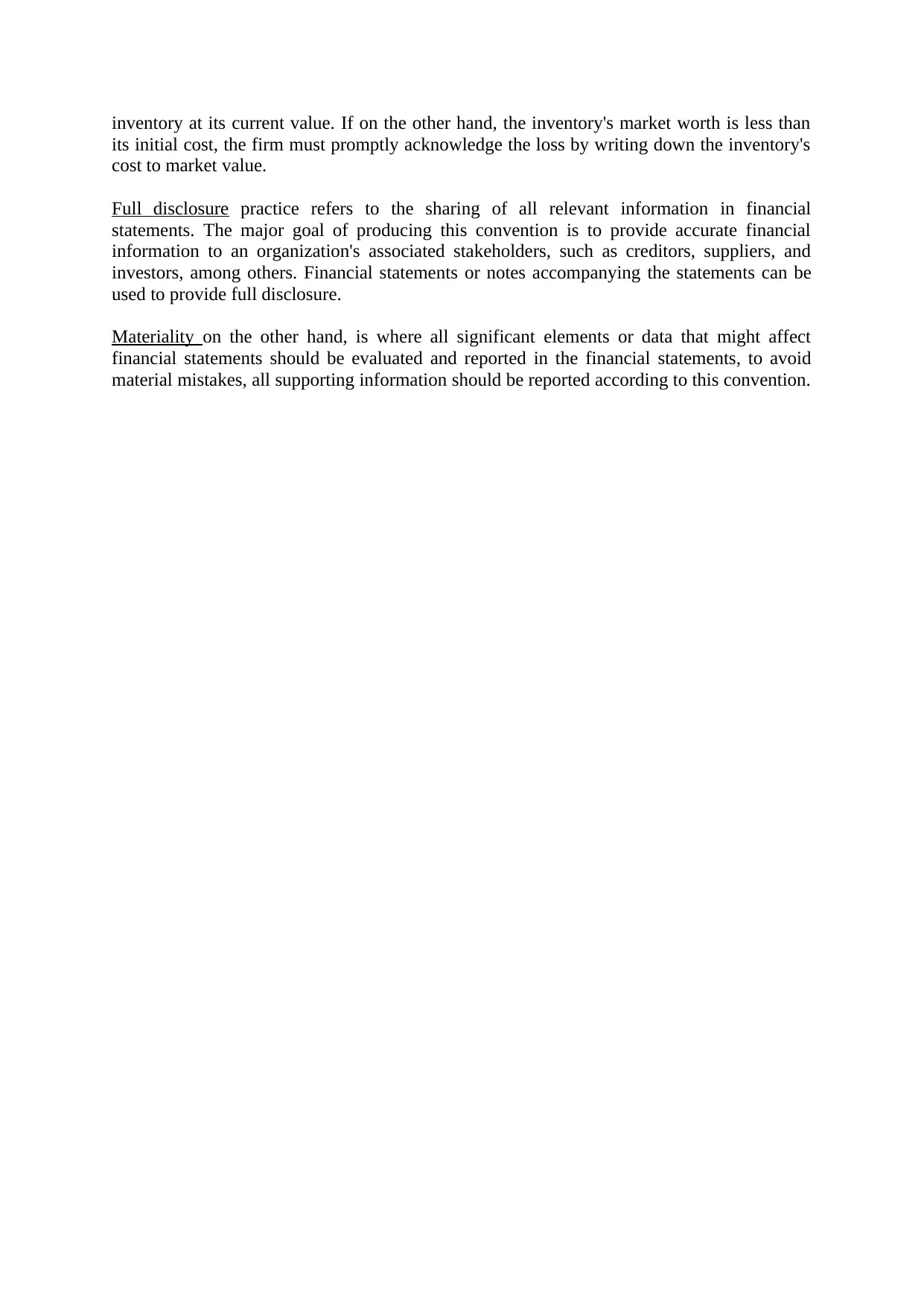
inventory at its current value. If on the other hand, the inventory's market worth is less than
its initial cost, the firm must promptly acknowledge the loss by writing down the inventory's
cost to market value.
Full disclosure practice refers to the sharing of all relevant information in financial
statements. The major goal of producing this convention is to provide accurate financial
information to an organization's associated stakeholders, such as creditors, suppliers, and
investors, among others. Financial statements or notes accompanying the statements can be
used to provide full disclosure.
Materiality on the other hand, is where all significant elements or data that might affect
financial statements should be evaluated and reported in the financial statements, to avoid
material mistakes, all supporting information should be reported according to this convention.
its initial cost, the firm must promptly acknowledge the loss by writing down the inventory's
cost to market value.
Full disclosure practice refers to the sharing of all relevant information in financial
statements. The major goal of producing this convention is to provide accurate financial
information to an organization's associated stakeholders, such as creditors, suppliers, and
investors, among others. Financial statements or notes accompanying the statements can be
used to provide full disclosure.
Materiality on the other hand, is where all significant elements or data that might affect
financial statements should be evaluated and reported in the financial statements, to avoid
material mistakes, all supporting information should be reported according to this convention.
Paraphrase This Document
Need a fresh take? Get an instant paraphrase of this document with our AI Paraphraser
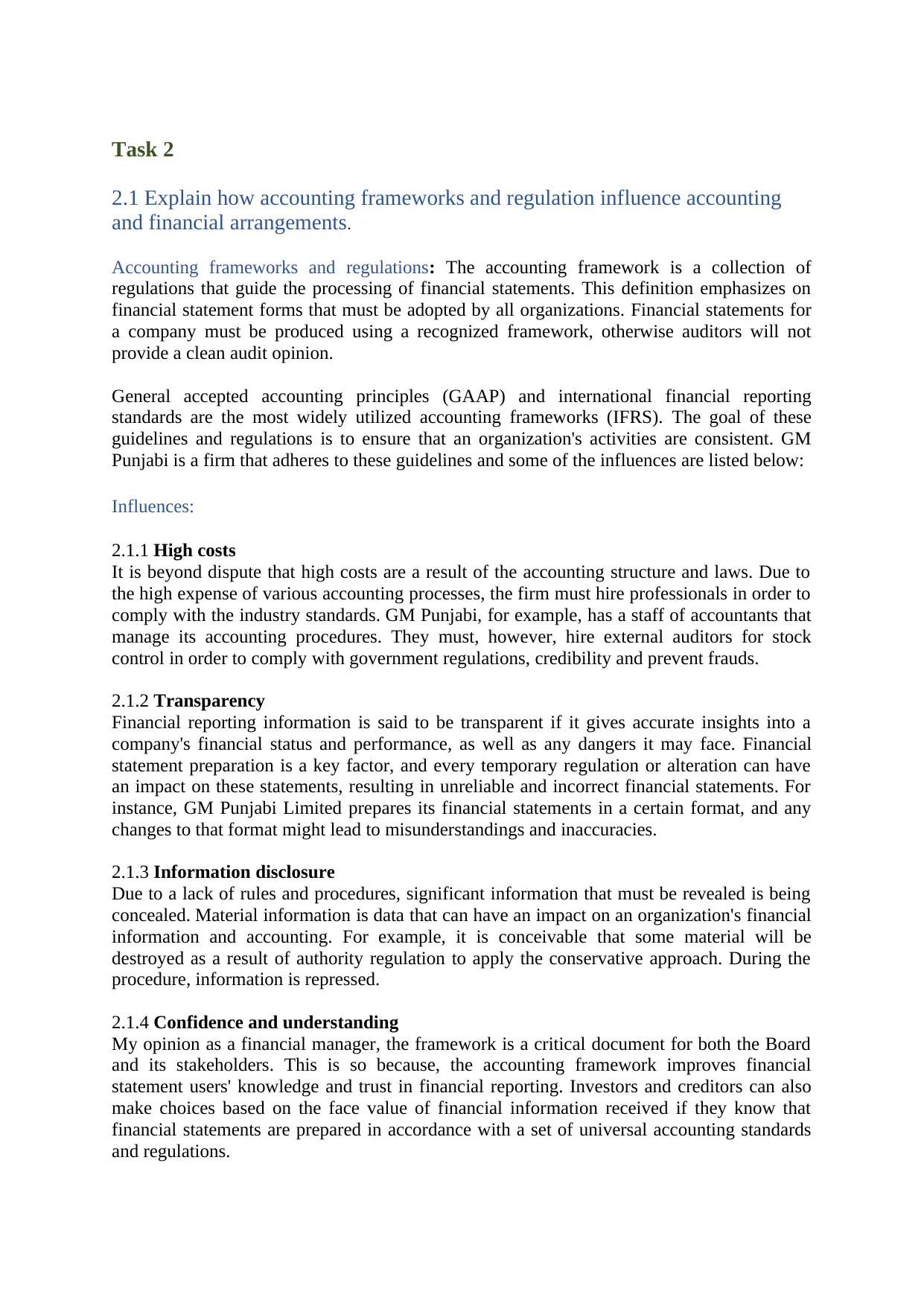
Task 2
2.1 Explain how accounting frameworks and regulation influence accounting
and financial arrangements.
Accounting frameworks and regulations: The accounting framework is a collection of
regulations that guide the processing of financial statements. This definition emphasizes on
financial statement forms that must be adopted by all organizations. Financial statements for
a company must be produced using a recognized framework, otherwise auditors will not
provide a clean audit opinion.
General accepted accounting principles (GAAP) and international financial reporting
standards are the most widely utilized accounting frameworks (IFRS). The goal of these
guidelines and regulations is to ensure that an organization's activities are consistent. GM
Punjabi is a firm that adheres to these guidelines and some of the influences are listed below:
Influences:
2.1.1 High costs
It is beyond dispute that high costs are a result of the accounting structure and laws. Due to
the high expense of various accounting processes, the firm must hire professionals in order to
comply with the industry standards. GM Punjabi, for example, has a staff of accountants that
manage its accounting procedures. They must, however, hire external auditors for stock
control in order to comply with government regulations, credibility and prevent frauds.
2.1.2 Transparency
Financial reporting information is said to be transparent if it gives accurate insights into a
company's financial status and performance, as well as any dangers it may face. Financial
statement preparation is a key factor, and every temporary regulation or alteration can have
an impact on these statements, resulting in unreliable and incorrect financial statements. For
instance, GM Punjabi Limited prepares its financial statements in a certain format, and any
changes to that format might lead to misunderstandings and inaccuracies.
2.1.3 Information disclosure
Due to a lack of rules and procedures, significant information that must be revealed is being
concealed. Material information is data that can have an impact on an organization's financial
information and accounting. For example, it is conceivable that some material will be
destroyed as a result of authority regulation to apply the conservative approach. During the
procedure, information is repressed.
2.1.4 Confidence and understanding
My opinion as a financial manager, the framework is a critical document for both the Board
and its stakeholders. This is so because, the accounting framework improves financial
statement users' knowledge and trust in financial reporting. Investors and creditors can also
make choices based on the face value of financial information received if they know that
financial statements are prepared in accordance with a set of universal accounting standards
and regulations.
2.1 Explain how accounting frameworks and regulation influence accounting
and financial arrangements.
Accounting frameworks and regulations: The accounting framework is a collection of
regulations that guide the processing of financial statements. This definition emphasizes on
financial statement forms that must be adopted by all organizations. Financial statements for
a company must be produced using a recognized framework, otherwise auditors will not
provide a clean audit opinion.
General accepted accounting principles (GAAP) and international financial reporting
standards are the most widely utilized accounting frameworks (IFRS). The goal of these
guidelines and regulations is to ensure that an organization's activities are consistent. GM
Punjabi is a firm that adheres to these guidelines and some of the influences are listed below:
Influences:
2.1.1 High costs
It is beyond dispute that high costs are a result of the accounting structure and laws. Due to
the high expense of various accounting processes, the firm must hire professionals in order to
comply with the industry standards. GM Punjabi, for example, has a staff of accountants that
manage its accounting procedures. They must, however, hire external auditors for stock
control in order to comply with government regulations, credibility and prevent frauds.
2.1.2 Transparency
Financial reporting information is said to be transparent if it gives accurate insights into a
company's financial status and performance, as well as any dangers it may face. Financial
statement preparation is a key factor, and every temporary regulation or alteration can have
an impact on these statements, resulting in unreliable and incorrect financial statements. For
instance, GM Punjabi Limited prepares its financial statements in a certain format, and any
changes to that format might lead to misunderstandings and inaccuracies.
2.1.3 Information disclosure
Due to a lack of rules and procedures, significant information that must be revealed is being
concealed. Material information is data that can have an impact on an organization's financial
information and accounting. For example, it is conceivable that some material will be
destroyed as a result of authority regulation to apply the conservative approach. During the
procedure, information is repressed.
2.1.4 Confidence and understanding
My opinion as a financial manager, the framework is a critical document for both the Board
and its stakeholders. This is so because, the accounting framework improves financial
statement users' knowledge and trust in financial reporting. Investors and creditors can also
make choices based on the face value of financial information received if they know that
financial statements are prepared in accordance with a set of universal accounting standards
and regulations.
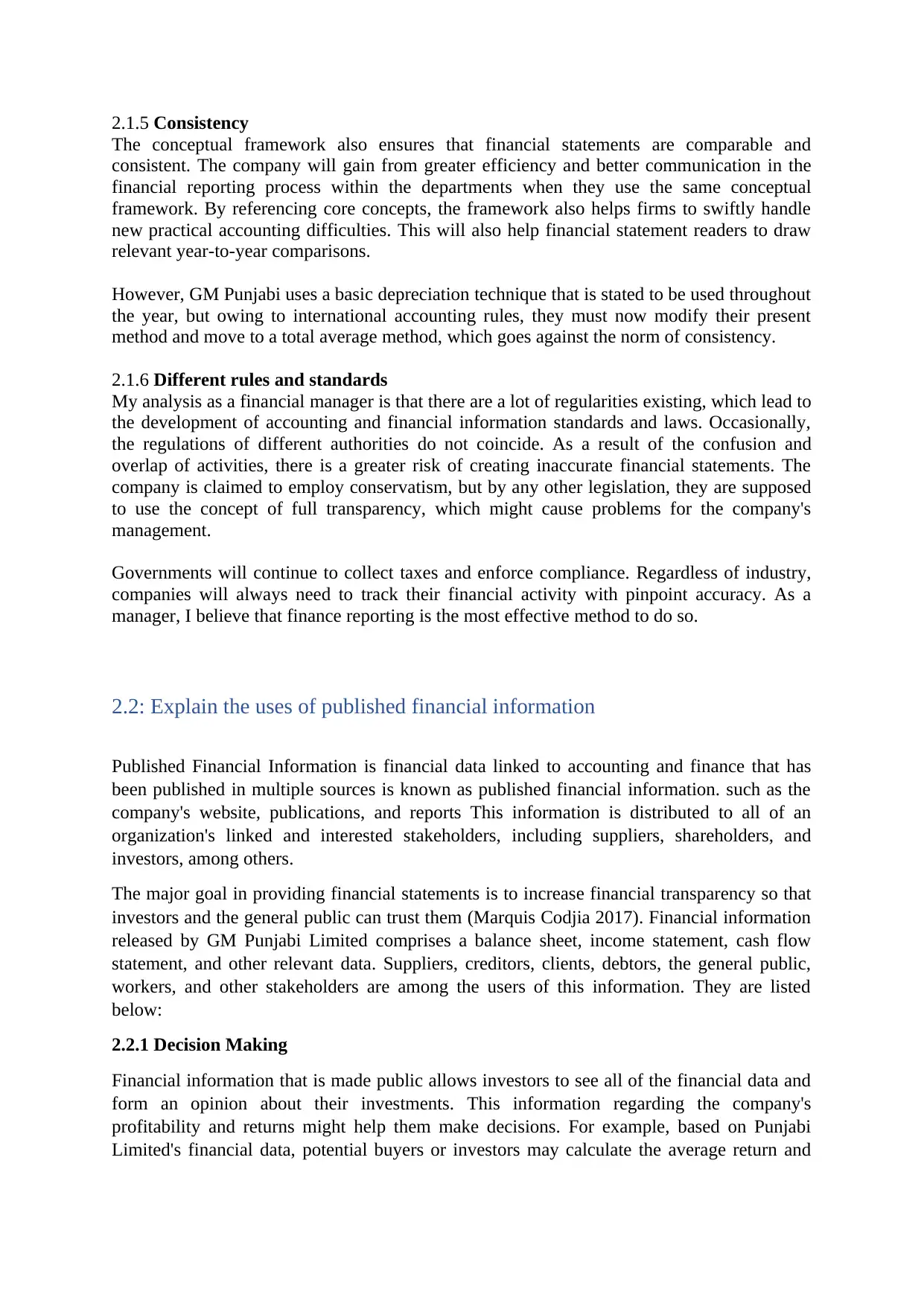
2.1.5 Consistency
The conceptual framework also ensures that financial statements are comparable and
consistent. The company will gain from greater efficiency and better communication in the
financial reporting process within the departments when they use the same conceptual
framework. By referencing core concepts, the framework also helps firms to swiftly handle
new practical accounting difficulties. This will also help financial statement readers to draw
relevant year-to-year comparisons.
However, GM Punjabi uses a basic depreciation technique that is stated to be used throughout
the year, but owing to international accounting rules, they must now modify their present
method and move to a total average method, which goes against the norm of consistency.
2.1.6 Different rules and standards
My analysis as a financial manager is that there are a lot of regularities existing, which lead to
the development of accounting and financial information standards and laws. Occasionally,
the regulations of different authorities do not coincide. As a result of the confusion and
overlap of activities, there is a greater risk of creating inaccurate financial statements. The
company is claimed to employ conservatism, but by any other legislation, they are supposed
to use the concept of full transparency, which might cause problems for the company's
management.
Governments will continue to collect taxes and enforce compliance. Regardless of industry,
companies will always need to track their financial activity with pinpoint accuracy. As a
manager, I believe that finance reporting is the most effective method to do so.
2.2: Explain the uses of published financial information
Published Financial Information is financial data linked to accounting and finance that has
been published in multiple sources is known as published financial information. such as the
company's website, publications, and reports This information is distributed to all of an
organization's linked and interested stakeholders, including suppliers, shareholders, and
investors, among others.
The major goal in providing financial statements is to increase financial transparency so that
investors and the general public can trust them (Marquis Codjia 2017). Financial information
released by GM Punjabi Limited comprises a balance sheet, income statement, cash flow
statement, and other relevant data. Suppliers, creditors, clients, debtors, the general public,
workers, and other stakeholders are among the users of this information. They are listed
below:
2.2.1 Decision Making
Financial information that is made public allows investors to see all of the financial data and
form an opinion about their investments. This information regarding the company's
profitability and returns might help them make decisions. For example, based on Punjabi
Limited's financial data, potential buyers or investors may calculate the average return and
The conceptual framework also ensures that financial statements are comparable and
consistent. The company will gain from greater efficiency and better communication in the
financial reporting process within the departments when they use the same conceptual
framework. By referencing core concepts, the framework also helps firms to swiftly handle
new practical accounting difficulties. This will also help financial statement readers to draw
relevant year-to-year comparisons.
However, GM Punjabi uses a basic depreciation technique that is stated to be used throughout
the year, but owing to international accounting rules, they must now modify their present
method and move to a total average method, which goes against the norm of consistency.
2.1.6 Different rules and standards
My analysis as a financial manager is that there are a lot of regularities existing, which lead to
the development of accounting and financial information standards and laws. Occasionally,
the regulations of different authorities do not coincide. As a result of the confusion and
overlap of activities, there is a greater risk of creating inaccurate financial statements. The
company is claimed to employ conservatism, but by any other legislation, they are supposed
to use the concept of full transparency, which might cause problems for the company's
management.
Governments will continue to collect taxes and enforce compliance. Regardless of industry,
companies will always need to track their financial activity with pinpoint accuracy. As a
manager, I believe that finance reporting is the most effective method to do so.
2.2: Explain the uses of published financial information
Published Financial Information is financial data linked to accounting and finance that has
been published in multiple sources is known as published financial information. such as the
company's website, publications, and reports This information is distributed to all of an
organization's linked and interested stakeholders, including suppliers, shareholders, and
investors, among others.
The major goal in providing financial statements is to increase financial transparency so that
investors and the general public can trust them (Marquis Codjia 2017). Financial information
released by GM Punjabi Limited comprises a balance sheet, income statement, cash flow
statement, and other relevant data. Suppliers, creditors, clients, debtors, the general public,
workers, and other stakeholders are among the users of this information. They are listed
below:
2.2.1 Decision Making
Financial information that is made public allows investors to see all of the financial data and
form an opinion about their investments. This information regarding the company's
profitability and returns might help them make decisions. For example, based on Punjabi
Limited's financial data, potential buyers or investors may calculate the average return and
⊘ This is a preview!⊘
Do you want full access?
Subscribe today to unlock all pages.

Trusted by 1+ million students worldwide
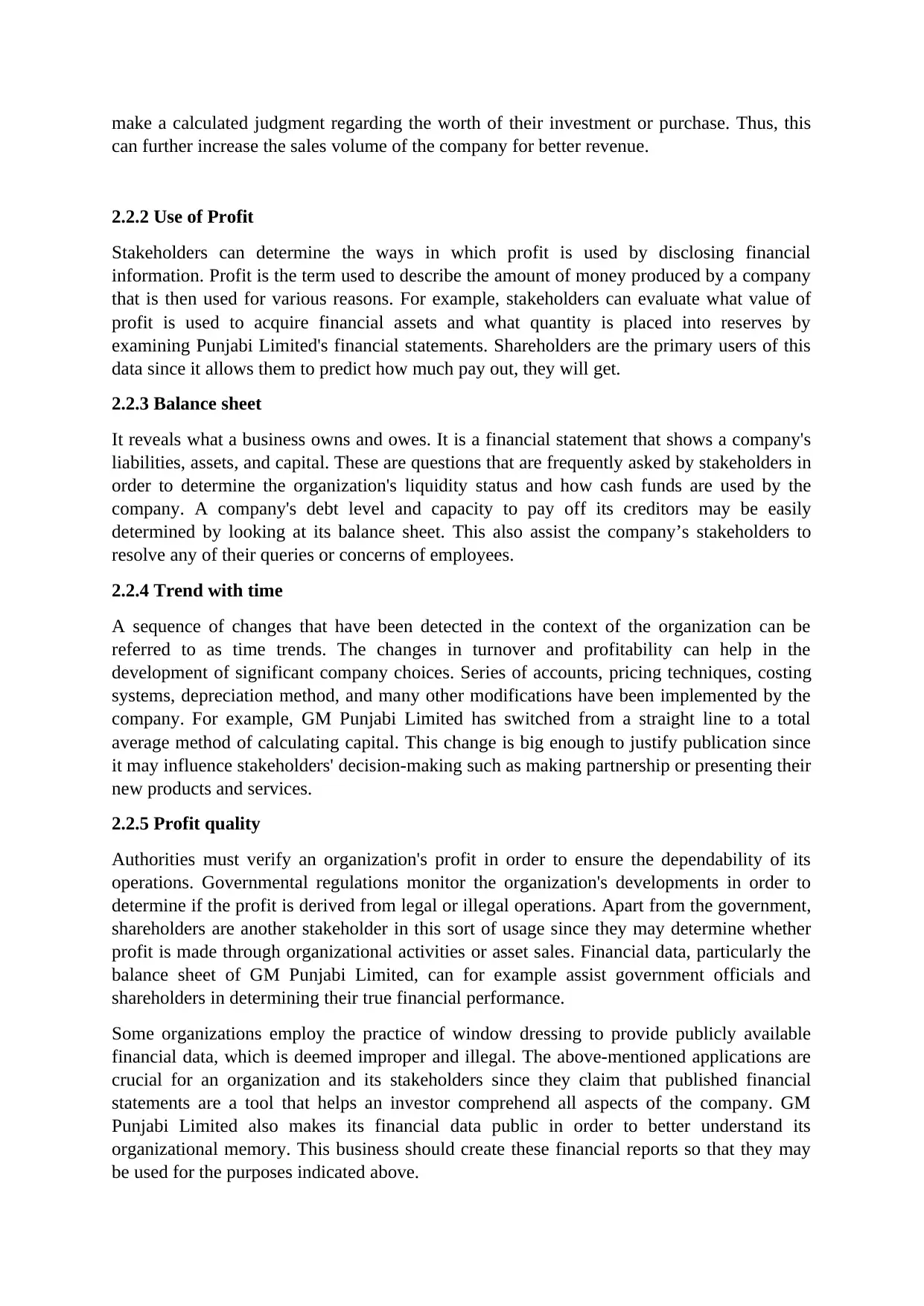
make a calculated judgment regarding the worth of their investment or purchase. Thus, this
can further increase the sales volume of the company for better revenue.
2.2.2 Use of Profit
Stakeholders can determine the ways in which profit is used by disclosing financial
information. Profit is the term used to describe the amount of money produced by a company
that is then used for various reasons. For example, stakeholders can evaluate what value of
profit is used to acquire financial assets and what quantity is placed into reserves by
examining Punjabi Limited's financial statements. Shareholders are the primary users of this
data since it allows them to predict how much pay out, they will get.
2.2.3 Balance sheet
It reveals what a business owns and owes. It is a financial statement that shows a company's
liabilities, assets, and capital. These are questions that are frequently asked by stakeholders in
order to determine the organization's liquidity status and how cash funds are used by the
company. A company's debt level and capacity to pay off its creditors may be easily
determined by looking at its balance sheet. This also assist the company’s stakeholders to
resolve any of their queries or concerns of employees.
2.2.4 Trend with time
A sequence of changes that have been detected in the context of the organization can be
referred to as time trends. The changes in turnover and profitability can help in the
development of significant company choices. Series of accounts, pricing techniques, costing
systems, depreciation method, and many other modifications have been implemented by the
company. For example, GM Punjabi Limited has switched from a straight line to a total
average method of calculating capital. This change is big enough to justify publication since
it may influence stakeholders' decision-making such as making partnership or presenting their
new products and services.
2.2.5 Profit quality
Authorities must verify an organization's profit in order to ensure the dependability of its
operations. Governmental regulations monitor the organization's developments in order to
determine if the profit is derived from legal or illegal operations. Apart from the government,
shareholders are another stakeholder in this sort of usage since they may determine whether
profit is made through organizational activities or asset sales. Financial data, particularly the
balance sheet of GM Punjabi Limited, can for example assist government officials and
shareholders in determining their true financial performance.
Some organizations employ the practice of window dressing to provide publicly available
financial data, which is deemed improper and illegal. The above-mentioned applications are
crucial for an organization and its stakeholders since they claim that published financial
statements are a tool that helps an investor comprehend all aspects of the company. GM
Punjabi Limited also makes its financial data public in order to better understand its
organizational memory. This business should create these financial reports so that they may
be used for the purposes indicated above.
can further increase the sales volume of the company for better revenue.
2.2.2 Use of Profit
Stakeholders can determine the ways in which profit is used by disclosing financial
information. Profit is the term used to describe the amount of money produced by a company
that is then used for various reasons. For example, stakeholders can evaluate what value of
profit is used to acquire financial assets and what quantity is placed into reserves by
examining Punjabi Limited's financial statements. Shareholders are the primary users of this
data since it allows them to predict how much pay out, they will get.
2.2.3 Balance sheet
It reveals what a business owns and owes. It is a financial statement that shows a company's
liabilities, assets, and capital. These are questions that are frequently asked by stakeholders in
order to determine the organization's liquidity status and how cash funds are used by the
company. A company's debt level and capacity to pay off its creditors may be easily
determined by looking at its balance sheet. This also assist the company’s stakeholders to
resolve any of their queries or concerns of employees.
2.2.4 Trend with time
A sequence of changes that have been detected in the context of the organization can be
referred to as time trends. The changes in turnover and profitability can help in the
development of significant company choices. Series of accounts, pricing techniques, costing
systems, depreciation method, and many other modifications have been implemented by the
company. For example, GM Punjabi Limited has switched from a straight line to a total
average method of calculating capital. This change is big enough to justify publication since
it may influence stakeholders' decision-making such as making partnership or presenting their
new products and services.
2.2.5 Profit quality
Authorities must verify an organization's profit in order to ensure the dependability of its
operations. Governmental regulations monitor the organization's developments in order to
determine if the profit is derived from legal or illegal operations. Apart from the government,
shareholders are another stakeholder in this sort of usage since they may determine whether
profit is made through organizational activities or asset sales. Financial data, particularly the
balance sheet of GM Punjabi Limited, can for example assist government officials and
shareholders in determining their true financial performance.
Some organizations employ the practice of window dressing to provide publicly available
financial data, which is deemed improper and illegal. The above-mentioned applications are
crucial for an organization and its stakeholders since they claim that published financial
statements are a tool that helps an investor comprehend all aspects of the company. GM
Punjabi Limited also makes its financial data public in order to better understand its
organizational memory. This business should create these financial reports so that they may
be used for the purposes indicated above.
Paraphrase This Document
Need a fresh take? Get an instant paraphrase of this document with our AI Paraphraser
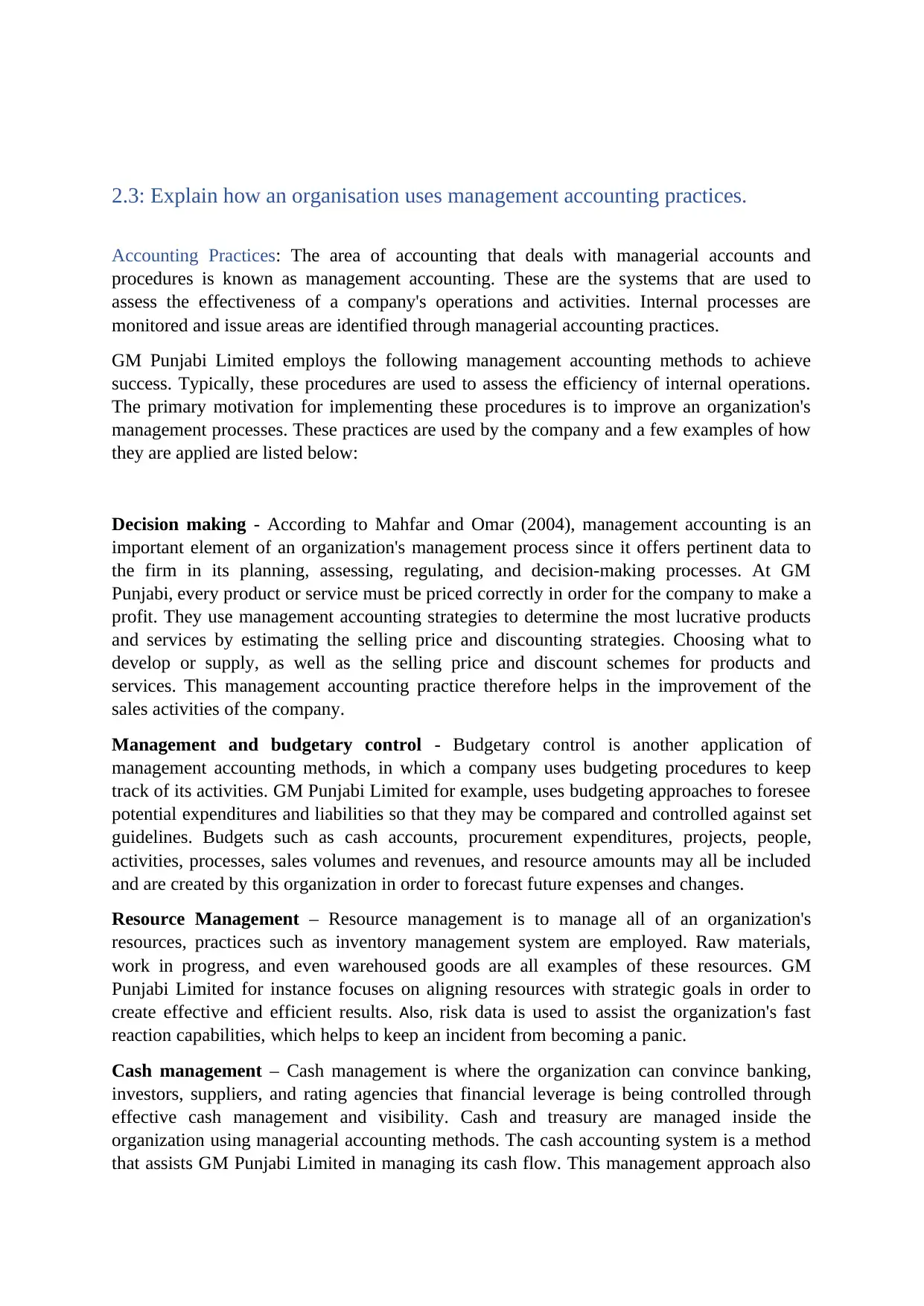
2.3: Explain how an organisation uses management accounting practices.
Accounting Practices: The area of accounting that deals with managerial accounts and
procedures is known as management accounting. These are the systems that are used to
assess the effectiveness of a company's operations and activities. Internal processes are
monitored and issue areas are identified through managerial accounting practices.
GM Punjabi Limited employs the following management accounting methods to achieve
success. Typically, these procedures are used to assess the efficiency of internal operations.
The primary motivation for implementing these procedures is to improve an organization's
management processes. These practices are used by the company and a few examples of how
they are applied are listed below:
Decision making - According to Mahfar and Omar (2004), management accounting is an
important element of an organization's management process since it offers pertinent data to
the firm in its planning, assessing, regulating, and decision-making processes. At GM
Punjabi, every product or service must be priced correctly in order for the company to make a
profit. They use management accounting strategies to determine the most lucrative products
and services by estimating the selling price and discounting strategies. Choosing what to
develop or supply, as well as the selling price and discount schemes for products and
services. This management accounting practice therefore helps in the improvement of the
sales activities of the company.
Management and budgetary control - Budgetary control is another application of
management accounting methods, in which a company uses budgeting procedures to keep
track of its activities. GM Punjabi Limited for example, uses budgeting approaches to foresee
potential expenditures and liabilities so that they may be compared and controlled against set
guidelines. Budgets such as cash accounts, procurement expenditures, projects, people,
activities, processes, sales volumes and revenues, and resource amounts may all be included
and are created by this organization in order to forecast future expenses and changes.
Resource Management – Resource management is to manage all of an organization's
resources, practices such as inventory management system are employed. Raw materials,
work in progress, and even warehoused goods are all examples of these resources. GM
Punjabi Limited for instance focuses on aligning resources with strategic goals in order to
create effective and efficient results. Also, risk data is used to assist the organization's fast
reaction capabilities, which helps to keep an incident from becoming a panic.
Cash management – Cash management is where the organization can convince banking,
investors, suppliers, and rating agencies that financial leverage is being controlled through
effective cash management and visibility. Cash and treasury are managed inside the
organization using managerial accounting methods. The cash accounting system is a method
that assists GM Punjabi Limited in managing its cash flow. This management approach also
Accounting Practices: The area of accounting that deals with managerial accounts and
procedures is known as management accounting. These are the systems that are used to
assess the effectiveness of a company's operations and activities. Internal processes are
monitored and issue areas are identified through managerial accounting practices.
GM Punjabi Limited employs the following management accounting methods to achieve
success. Typically, these procedures are used to assess the efficiency of internal operations.
The primary motivation for implementing these procedures is to improve an organization's
management processes. These practices are used by the company and a few examples of how
they are applied are listed below:
Decision making - According to Mahfar and Omar (2004), management accounting is an
important element of an organization's management process since it offers pertinent data to
the firm in its planning, assessing, regulating, and decision-making processes. At GM
Punjabi, every product or service must be priced correctly in order for the company to make a
profit. They use management accounting strategies to determine the most lucrative products
and services by estimating the selling price and discounting strategies. Choosing what to
develop or supply, as well as the selling price and discount schemes for products and
services. This management accounting practice therefore helps in the improvement of the
sales activities of the company.
Management and budgetary control - Budgetary control is another application of
management accounting methods, in which a company uses budgeting procedures to keep
track of its activities. GM Punjabi Limited for example, uses budgeting approaches to foresee
potential expenditures and liabilities so that they may be compared and controlled against set
guidelines. Budgets such as cash accounts, procurement expenditures, projects, people,
activities, processes, sales volumes and revenues, and resource amounts may all be included
and are created by this organization in order to forecast future expenses and changes.
Resource Management – Resource management is to manage all of an organization's
resources, practices such as inventory management system are employed. Raw materials,
work in progress, and even warehoused goods are all examples of these resources. GM
Punjabi Limited for instance focuses on aligning resources with strategic goals in order to
create effective and efficient results. Also, risk data is used to assist the organization's fast
reaction capabilities, which helps to keep an incident from becoming a panic.
Cash management – Cash management is where the organization can convince banking,
investors, suppliers, and rating agencies that financial leverage is being controlled through
effective cash management and visibility. Cash and treasury are managed inside the
organization using managerial accounting methods. The cash accounting system is a method
that assists GM Punjabi Limited in managing its cash flow. This management approach also
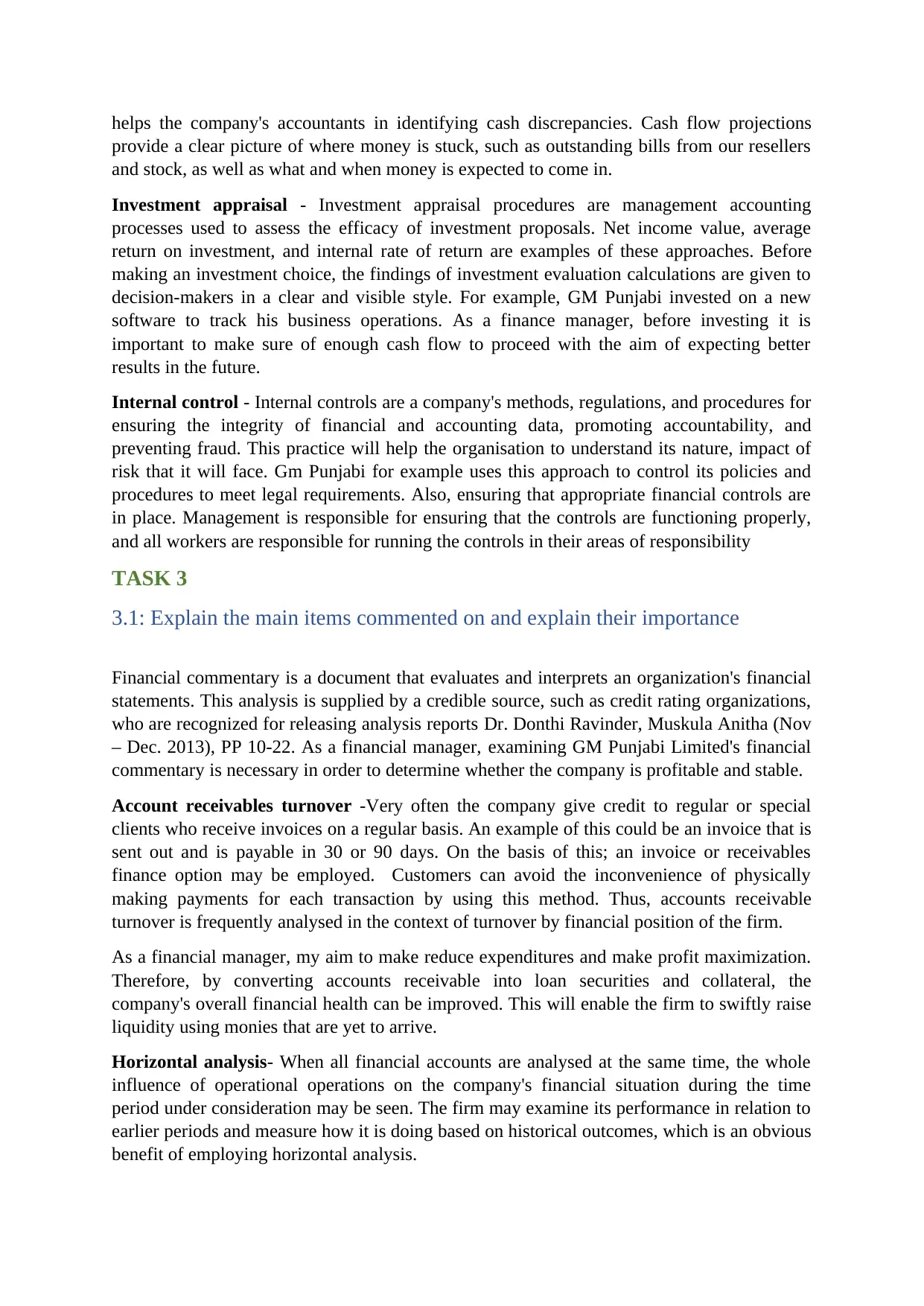
helps the company's accountants in identifying cash discrepancies. Cash flow projections
provide a clear picture of where money is stuck, such as outstanding bills from our resellers
and stock, as well as what and when money is expected to come in.
Investment appraisal - Investment appraisal procedures are management accounting
processes used to assess the efficacy of investment proposals. Net income value, average
return on investment, and internal rate of return are examples of these approaches. Before
making an investment choice, the findings of investment evaluation calculations are given to
decision-makers in a clear and visible style. For example, GM Punjabi invested on a new
software to track his business operations. As a finance manager, before investing it is
important to make sure of enough cash flow to proceed with the aim of expecting better
results in the future.
Internal control - Internal controls are a company's methods, regulations, and procedures for
ensuring the integrity of financial and accounting data, promoting accountability, and
preventing fraud. This practice will help the organisation to understand its nature, impact of
risk that it will face. Gm Punjabi for example uses this approach to control its policies and
procedures to meet legal requirements. Also, ensuring that appropriate financial controls are
in place. Management is responsible for ensuring that the controls are functioning properly,
and all workers are responsible for running the controls in their areas of responsibility
TASK 3
3.1: Explain the main items commented on and explain their importance
Financial commentary is a document that evaluates and interprets an organization's financial
statements. This analysis is supplied by a credible source, such as credit rating organizations,
who are recognized for releasing analysis reports Dr. Donthi Ravinder, Muskula Anitha (Nov
– Dec. 2013), PP 10-22. As a financial manager, examining GM Punjabi Limited's financial
commentary is necessary in order to determine whether the company is profitable and stable.
Account receivables turnover -Very often the company give credit to regular or special
clients who receive invoices on a regular basis. An example of this could be an invoice that is
sent out and is payable in 30 or 90 days. On the basis of this; an invoice or receivables
finance option may be employed. Customers can avoid the inconvenience of physically
making payments for each transaction by using this method. Thus, accounts receivable
turnover is frequently analysed in the context of turnover by financial position of the firm.
As a financial manager, my aim to make reduce expenditures and make profit maximization.
Therefore, by converting accounts receivable into loan securities and collateral, the
company's overall financial health can be improved. This will enable the firm to swiftly raise
liquidity using monies that are yet to arrive.
Horizontal analysis- When all financial accounts are analysed at the same time, the whole
influence of operational operations on the company's financial situation during the time
period under consideration may be seen. The firm may examine its performance in relation to
earlier periods and measure how it is doing based on historical outcomes, which is an obvious
benefit of employing horizontal analysis.
provide a clear picture of where money is stuck, such as outstanding bills from our resellers
and stock, as well as what and when money is expected to come in.
Investment appraisal - Investment appraisal procedures are management accounting
processes used to assess the efficacy of investment proposals. Net income value, average
return on investment, and internal rate of return are examples of these approaches. Before
making an investment choice, the findings of investment evaluation calculations are given to
decision-makers in a clear and visible style. For example, GM Punjabi invested on a new
software to track his business operations. As a finance manager, before investing it is
important to make sure of enough cash flow to proceed with the aim of expecting better
results in the future.
Internal control - Internal controls are a company's methods, regulations, and procedures for
ensuring the integrity of financial and accounting data, promoting accountability, and
preventing fraud. This practice will help the organisation to understand its nature, impact of
risk that it will face. Gm Punjabi for example uses this approach to control its policies and
procedures to meet legal requirements. Also, ensuring that appropriate financial controls are
in place. Management is responsible for ensuring that the controls are functioning properly,
and all workers are responsible for running the controls in their areas of responsibility
TASK 3
3.1: Explain the main items commented on and explain their importance
Financial commentary is a document that evaluates and interprets an organization's financial
statements. This analysis is supplied by a credible source, such as credit rating organizations,
who are recognized for releasing analysis reports Dr. Donthi Ravinder, Muskula Anitha (Nov
– Dec. 2013), PP 10-22. As a financial manager, examining GM Punjabi Limited's financial
commentary is necessary in order to determine whether the company is profitable and stable.
Account receivables turnover -Very often the company give credit to regular or special
clients who receive invoices on a regular basis. An example of this could be an invoice that is
sent out and is payable in 30 or 90 days. On the basis of this; an invoice or receivables
finance option may be employed. Customers can avoid the inconvenience of physically
making payments for each transaction by using this method. Thus, accounts receivable
turnover is frequently analysed in the context of turnover by financial position of the firm.
As a financial manager, my aim to make reduce expenditures and make profit maximization.
Therefore, by converting accounts receivable into loan securities and collateral, the
company's overall financial health can be improved. This will enable the firm to swiftly raise
liquidity using monies that are yet to arrive.
Horizontal analysis- When all financial accounts are analysed at the same time, the whole
influence of operational operations on the company's financial situation during the time
period under consideration may be seen. The firm may examine its performance in relation to
earlier periods and measure how it is doing based on historical outcomes, which is an obvious
benefit of employing horizontal analysis.
⊘ This is a preview!⊘
Do you want full access?
Subscribe today to unlock all pages.

Trusted by 1+ million students worldwide
1 out of 18
Related Documents
Your All-in-One AI-Powered Toolkit for Academic Success.
+13062052269
info@desklib.com
Available 24*7 on WhatsApp / Email
![[object Object]](/_next/static/media/star-bottom.7253800d.svg)
Unlock your academic potential
Copyright © 2020–2025 A2Z Services. All Rights Reserved. Developed and managed by ZUCOL.




